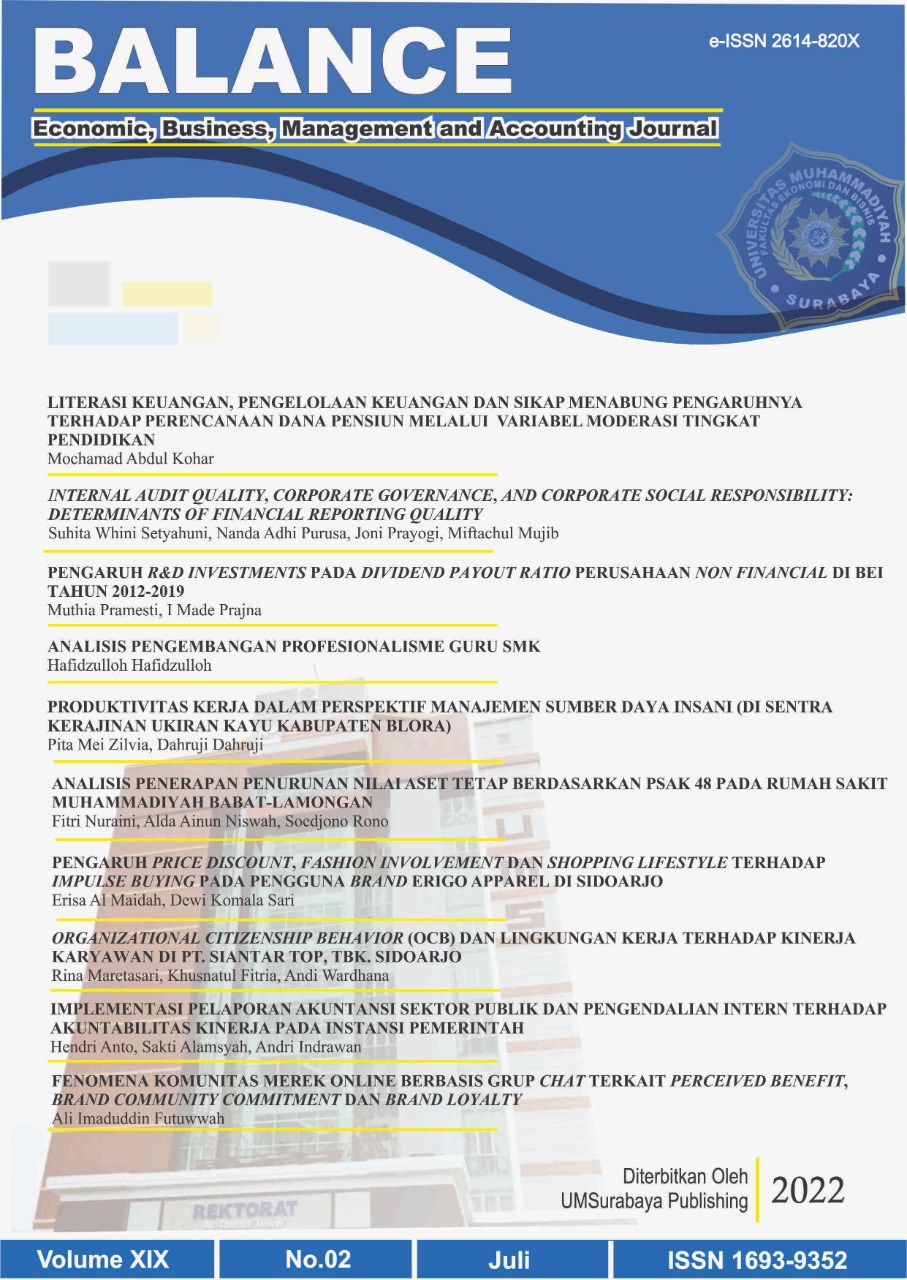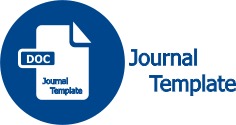Pengaruh R&D Investments Pada Dividend Payout Ratio Perusahaan Non Financial Di BEI Tahun 2012-2019
DOI:
https://doi.org/10.30651/blc.v19i2.12321Kata Kunci:
Cash Holding, Dividend Payout Ratio, Internal Financing Deficit, Perusahaan Non-Finansial, R&D Investment.Abstrak
Tujuan dari penelitian ini untuk menemukan pengaruh R&D investments pada Dividend Payout Ratio perusahaan non-finansial di Bursa Efek Indonesia (BEI) dari 2012 – 2019. Seluruh data dan statistic yang telah dikumpulkan diolah memanfaatkan Tobit Regression Left-Censored Model. Penelitian ini menemukan bukti bahwa R&D investments tidak berpengaruh terhadap kebijakan dividend (Dividend Payout Ratio) perusahaan non-finansial. Tidak adanya pengaruh antara R&D investments terhadap Dividend Payout Ratio perusahaan non-finansial ini ini dapat ditemukan pada perilaku investor Indonesia serta kondisi institusional negara Indonesia. Dengan demikian, penelitian ini akan berkontribusi memberikan pemahaman yang lebih jauh kepada peneliti lainnya maupun sebagai bahan pertimbangan bagi perusahaan dalam pembuatan dan penentuan kebijakan dividend perusahaan non-finansial di IndonesiaReferensi
Aboody, D., & Lev, B. (2000). Information asymmetry, R&D and insider gains. The Journal of Finance, 2747-2766.
Acharya, V., & Xu, Z. (2017). Financial dependence and innovation: The case of public versus private firms. Journal of Financial Economics, 223-243.
Al-Malkawi, H. N., Rafferty, M., & Pillai, R. (2010). Dividend Policy: A Review of Theories and Empirical Evidence. International Bulletin of Business Administration, 171-200.
Al-Najjar, B. (2011). Corporate cash holdings and dividend payments: Evidence from simultaneous analysis. Managerial and Decision Economics, 231-241.
Azwar, S. (1999). Metode Penelitian. Yogyakarta: Pustaka Pelajar.
Bali, R. (2003). An Empirical Analysis of Stock Returns Around Dividend Changes. Applied Economics , 51-61.
Bao, Y., Hsin-I, C., & Jing, Z. (2020). Innovation or Dividend Payout: Evidence from China. International Review of Economics and Finance, 180-203.
Bates, T. W., Kahle, K. M., & Stulz, R. M. (2009). Why do U.S firms hold so much more cash than they used to? The Journal of Finance, 1985-2021.
Berry, Y. (2016). Hubungan Kebijakan Dividen dan Nilai Perusahaan pada Tahap Mature dan Growth. JRAK, 65-73.
Bradford, W., Chen, C., & Zhu, S. (2013). Cash dividend policy, corporate pyramids, and ownership structure: Evidence from China. International Review of Economics & Finance, 445-464.
Brockman, P., & Unlu, E. (2009). Dividend Policy, creditor rights, and the agency costs of debt. Journal of Financial Economics, 276-298.
Brown, J. R., & Petersen, B. C. (2011). Cash holdings and R&D smoothing. Journal of Corporate Finance, 694-709.
Brown, J. R., & Petersen, B. C. (2015). Which investments do firms protect? Liquidity management and real adjustments when access to finance falls sharply. Journal of Financial Intermediation, 441-465.
Brown, J. R., Fazzari, S. M., & Petersen, B. C. (2009). Financing Innovation and Growth: Cash Flow, External Equity, and the 1990s R&D Boom. The Journal of Finance, 151-185.
Brown, J. R., Martinsson, G., & Petersen, B. C. (2012). Do financing constraints matter for R&D? European Economic Review, 1512-1529.
Chen, J., Leung, W. S., & Goergen, M. (2017). The impact of board gender composition on dividend payouts. Journal of Corporate Finance, 86-105.
Cooper, D. R., & Schindler, P. S. (2013). Business Research Methods Twelfth Edition. New York: McGraw-Hill Irwin.
DeAngelo, H., DeAngelo, L., & Stulz, R. M. (2006). Dividend policy and the earned/contributed capital mix: A test of the life-cycle theory. Journal of Financial Economics, 227-254.
Deng, Li, Liao, & Xu. (2013). Dividends, investment and cash flow uncertainty: Evidence from China. International Review of Economics & Finance, 112-124.
Denis, D. J. (2011). FInancial flexibility and corporate liquidity. Journal of Corporate Finance, 667-674.
Denis, D., & Osobov, I. (2008). Why do firms pay dividends? International evidence on the determinants of dividend policy. Journal of Financial Economics, 62-82.
Firmansyah, Sudarma, & Yeney. (2016). Faktor Internaldan Eksternal Yang Berpengaruh Terhadap . Jurnal Balance Vol. XIII No. 1, 25-43.
Frank, M., & Goyal, V. (2003). Testing the pecking order theory of capital structure. Journal of Financial Economics, 217-248.
Franzen, L. A., Rodgers, K. J., & Simin, T. T. (2007). Measuring distress risk: The effect of R&D intensity. The Journal of Finance, 2931-2967.
Gamayuni, R. (2009). Perkembangan Standar Akuntansi Keuangan Indonesia Menuju International Financial Reporting Standards. Jurnal Akuntansi dan Keuangan , 153-166.
Ghozali. (2006). Statistik Non parametrik : Teori dan aplikasi dengan program SPSS. Semarang: Badan Penerbit Universitas Diponegoro.
Ghozali. (2016). Aplikasi Analisis Multivariete Dengan Program IBM SPSS 23. Edisi 8. Semarang: Badan Penerbit Universitas Diponegoro.
Gordon, M. J. (1959). Dividends, Earnings, and Stock Prices. Review of Economics and Statistics, 99-105.
Guariglia, A., & Liu, P. (2014). To what extent do financing constraints affect Chinese firms' innovation activities? International Review of Financial Analysis, 223-240.
Gugler, K. (2003). Corporate governance, dividend payout policy, and the interrelation between dividends, R&D, and capital investment. Journal of Banking & Finance, 1297-1321.
Gul, F., & Tsui, J. (1998). A test of the free cash flow and debt monitoring hypotheses: Evidence from audit pricing. Journal of Accounting and Economics, 219-237.
Guney, Y., Karpuz, A., & OZkan, N. (2017). R&D investments and credit lines. Journal of Corporate Finance, 261-283.
Hall, B. H. (2002). The financing of research and development. Oxford Review of Economic Policy, 35-51.
Hall, B. H. (2006). Research and Development. Contribution to the International Encyclopedia of the Social Sciences, second edition.
Harmasanto, D. H., & Setiawan, R. (2019). Pengeluaran R&D dan Kinerja Perusahaan Manufaktur di Bursa Efek Indonesia yang Dimoderasi oleh Usia Perusahaan. Jurnal Riset Akuntansi dan Bisnis Airlangga, 644-668.
Harsono, M. (2002). Prosedur Pengujian Variabel Kontrol dan Moderator Dalam Penelitian Perilaku Dengan Menggunakan SPSS 10.00. Fakultas Ekonomi Universitas Sebelas Maret.
Himmelberg, C. P., & Petersen, B. C. (1994). R & D and Internal Finance: A Panel Study of Small Firms in High-Tech Industries. The Review of Economics and Statistics, 38-51.
Holmstorm, B., & Tirole, J. (1998). Private and public supply of liquidity. Journal of Political Economy, 1-40.
Huang, J. J., Shen, Y., & Sun, Q. (2011). Nonnegotiable shares, controlling shareholders and dividend payments in China. Journal of Corporate Finance, 122-133.
Janavi, M. D. (2017). Analisis Determinan Kebijakan Dividend pada Perusahaan Manufaktur Sub Sektor Makanan dan Minuman yang ada di Bursa Efek Indonesia Periode 2011-2016. Bogor: Fakultas Ekonomi Universitas Pakuan .
Jensen, M. C. (1986). Agency costs of free cash flow, corporate finance, and takeovers. The American Economic Review, 323-329.
Kim, W., & Weisbach, M. S. (2008). Motivations for public equity offers: An international perspective. Journal of Financial Economics, 281-307.
Koo, D. S., Ramalingegowda, S., & Yu, Y. (2017). The effect of financial reporting quality on corporate dividend policy. Review of Accounting Studies, 753-790.
Lei, J., Qiu, J., & Wan, C. (2018). Asset tangibility, cash holdings, and financial development. Journal of Corporate Finance, 223-242.
Lintner, J. (1962). Dividends, Earnings, Leverage, Stock Prices and Supply of Capital to Corporations. The Review of Economics and Statistics, 243-269.
Lyandres, E., & Palazzo, B. (2016). Cash holdings, competition, and innovation. Journal of Financial and Quantitative Analysis, 1823-1861.
Marietta, U., & Sampurno, D. (2013). Analisis Pengaruh Cash Ratio, Return On Assets, Growth, Firm Size, Debt to Equity Ratio Terhadap Dividend Payout Ratio : (Studi Pada Perusahaan Manufaktur Yang Terdaftar di Bursa Efek Indonesia Tahun 2008-2011). Diponegoro Journal of Management, 319-329.
McLean, R. D. (2011). Share issuance and cash savings. Journal of Financial Economics, 693-715.
Miller, & Modigliani. (1961). Dividend Policy, Growth, and the Valuation of Shares. Journal of Business, 411-433.
Myers, S. C., & Majluf, N. S. (1984). Corporate financing and investment decisions when firms have information that investors do not have. Journal of Financial Economics, 187-221.
Opler, T. (1999). The determinants and implications of corporate cash holdings. Journal of Financial Economics, 3-46.
Opler, T., Pinkowitz, L., Stulz, R. M., & Williamson, R. (1999). The determinants and implications of corporate cash holdings. Journal of Financial Economics, 3-46.
Prihadyanti, D., & Laksani, C. S. (2015). R & D dan Inovasi di Perusahaan Sektor Manufaktur Indonesia. Jurnal Manajemen Teknologi, 187-198.
Primawestri, L. (2011). Analisis Faktor-Faktor Yang Mempengaruhi Kebijakan Dividend (Studi Empiris Perusahaan Manufaktur yang Listing di Bursa Efek Indonesia Periode 2006-2009). Semarang: Tesis, UNDIP.
Ramalingegowda, S., Wang, C., & Yu, Y. (2013). The role of financial reporting quality in mitigating the constraining effect of dividend policy on investment decisions. The Accounting Review, 1007-1039.
Schmitt, N. W., & Klimoski, R. J. (1991). Research Methods in Human Resources Management. Cincinati: South-Western Publishing Co.
Sekaran, U., & Bougie, R. (2016). Research Methods for Business: A Skill Building Approach Seventh Edition. Chichester: Wiley.
Sharma, V. (2011). Independent directors and the propensity to pay dividends. Journal of Corporate Finance, 1001-1015.
Sumani, Sandroto, & Mula. (2017). Perilaku Investor di Pasar Modal Indonesia. Jurnal Ekonomi dan Keuangan, 211-233.
Sutrisno, B. (2017). Hubungan Cash Holding dan Nilai Perusahaan di Indonesia. Jurnal Dinamika Akuntansi dan Bisnis, 45-56.
Tahir, M. S., Alifiah, M. N., Arshad, M. U., & Saleem, F. (2016). Financial Theories with a Focus on Corporate Cash Holding. International Journal of Economics and Financial, 215-219.
Tao, Nan, & Li. (2016). Information content of unexpected dividends under a semi-mandatory dividend policy: An empirical study of China. North American Journal of Economics and Finance, 297-318.
Usman, B. (2006). Variabel Penentu Keputusan Pembagian Dividend pada Perusahaan yang Go Publik di Indonesia Periode 2000-2002 (Tinjauan terhadap Signaling Theory). Media Riset Bisnis & Manajemen, Vol. 6 No. 1 hal 23-46.
Wasiuzzaman. (2014). Analysis of corporate cash holdings of firms in Malaysia. Journal of Asia Business Studies, 118-135.
Wei, Z., Li, C., & Wu, Y. (2017). The semi-mandatory dividend rules, refinancing motivation and classical dividend theories––An empirical study based on agency theory and signaling theory. Accounting Research, 55-61.
Yang, C. H., & Chen, Y. H. (2012). R&D, productivity, and exports: Plant-level evidence from Indonesia. Economic Modelling, 208-216.
Yoo, T., & Rhee, M. (2013). Agency theory and the context for R&D investment: Evidence from Korea. Asian Business & Management, 227-252.
Zou, H., & Xiao, J. Z. (2006). The financing behaviour of listed Chinese firms. The British Accounting Review, 239-258.















